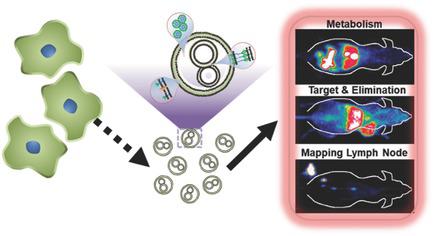当前位置:
X-MOL 学术
›
Adv. Mater.
›
论文详情
Our official English website, www.x-mol.net, welcomes your feedback! (Note: you will need to create a separate account there.)
Reassembly of 89Zr‐Labeled Cancer Cell Membranes into Multicompartment Membrane‐Derived Liposomes for PET‐Trackable Tumor‐Targeted Theranostics
Advanced Materials ( IF 29.4 ) Pub Date : 2018-02-12 , DOI: 10.1002/adma.201704934 Bo Yu 1, 2, 3 , Shreya Goel 2 , Dalong Ni 2 , Paul A Ellison 2 , Cerise M Siamof 2 , Dawei Jiang 2 , Liang Cheng 4 , Lei Kang 2, 5 , Faquan Yu 3 , Zhuang Liu 4 , Todd E Barnhart 2 , Qianjun He 1 , Han Zhang 6 , Weibo Cai 2, 7
Advanced Materials ( IF 29.4 ) Pub Date : 2018-02-12 , DOI: 10.1002/adma.201704934 Bo Yu 1, 2, 3 , Shreya Goel 2 , Dalong Ni 2 , Paul A Ellison 2 , Cerise M Siamof 2 , Dawei Jiang 2 , Liang Cheng 4 , Lei Kang 2, 5 , Faquan Yu 3 , Zhuang Liu 4 , Todd E Barnhart 2 , Qianjun He 1 , Han Zhang 6 , Weibo Cai 2, 7
Affiliation

|
Nanoengineering of cell membranes holds great potential to revolutionize tumor‐targeted theranostics, owing to their innate biocompatibility and ability to escape from the immune and reticuloendothelial systems. However, tailoring and integrating cell membranes with drug and imaging agents into one versatile nanoparticle are still challenging. Here, multicompartment membrane‐derived liposomes (MCLs) are developed by reassembling cancer cell membranes with Tween‐80, and are used to conjugate 89Zr via deferoxamine chelator and load tetrakis(4‐carboxyphenyl) porphyrin for in vivo noninvasive quantitative tracing by positron emission tomography imaging and photodynamic therapy (PDT), respectively. Radiolabeled constructs, 89Zr‐Df‐MCLs, demonstrate excellent radiochemical stability in vivo, target 4T1 tumors by the enhanced permeability and retention effect, and are retained long‐term for efficient and effective PDT while clearing gradually from the reticuloendothelial system via hepatobiliary excretion. Toxicity evaluation confirms that the MCLs do not impose acute or chronic toxicity in intravenously injected mice. Additionally, 89Zr‐labeled MCLs can execute rapid and highly sensitive lymph node mapping, even for deep‐seated sentinel lymph nodes. The as‐developed cell membrane reassembling route to MCLs could be extended to other cell types, providing a versatile platform for disease theranostics by facilely and efficiently integrating various multifunctional agents.
中文翻译:

将 89Zr 标记的癌细胞膜重新组装成多室膜衍生脂质体,用于 PET 可追踪的肿瘤靶向治疗
细胞膜纳米工程由于其固有的生物相容性以及逃离免疫和网状内皮系统的能力,具有彻底改变肿瘤靶向治疗诊断学的巨大潜力。然而,将细胞膜与药物和显像剂一起定制并整合到一种多功能纳米颗粒中仍然具有挑战性。在这里,多室膜衍生脂质体(MCL)是通过用 Tween-80 重新组装癌细胞膜而开发的,并用于通过去铁胺螯合剂缀合89 Zr 并负载四(4-羧基苯基)卟啉,用于通过正电子发射进行体内无创定量追踪分别是断层扫描成像和光动力疗法(PDT)。放射性标记的构建体89 Zr-Df-MCL 在体内表现出优异的放射化学稳定性,通过增强的渗透性和保留效应靶向 4T1 肿瘤,并长期保留以实现高效和有效的 PDT,同时通过肝胆排泄逐渐从网状内皮系统清除。毒性评估证实 MCL 不会对静脉注射的小鼠产生急性或慢性毒性。此外,89 Zr 标记的 MCL 可以执行快速且高度敏感的淋巴结定位,甚至对于深部前哨淋巴结也是如此。所开发的 MCL 细胞膜重组途径可以扩展到其他细胞类型,通过轻松有效地整合各种多功能试剂,为疾病治疗诊断提供多功能平台。
更新日期:2018-02-12
中文翻译:

将 89Zr 标记的癌细胞膜重新组装成多室膜衍生脂质体,用于 PET 可追踪的肿瘤靶向治疗
细胞膜纳米工程由于其固有的生物相容性以及逃离免疫和网状内皮系统的能力,具有彻底改变肿瘤靶向治疗诊断学的巨大潜力。然而,将细胞膜与药物和显像剂一起定制并整合到一种多功能纳米颗粒中仍然具有挑战性。在这里,多室膜衍生脂质体(MCL)是通过用 Tween-80 重新组装癌细胞膜而开发的,并用于通过去铁胺螯合剂缀合89 Zr 并负载四(4-羧基苯基)卟啉,用于通过正电子发射进行体内无创定量追踪分别是断层扫描成像和光动力疗法(PDT)。放射性标记的构建体89 Zr-Df-MCL 在体内表现出优异的放射化学稳定性,通过增强的渗透性和保留效应靶向 4T1 肿瘤,并长期保留以实现高效和有效的 PDT,同时通过肝胆排泄逐渐从网状内皮系统清除。毒性评估证实 MCL 不会对静脉注射的小鼠产生急性或慢性毒性。此外,89 Zr 标记的 MCL 可以执行快速且高度敏感的淋巴结定位,甚至对于深部前哨淋巴结也是如此。所开发的 MCL 细胞膜重组途径可以扩展到其他细胞类型,通过轻松有效地整合各种多功能试剂,为疾病治疗诊断提供多功能平台。



























 京公网安备 11010802027423号
京公网安备 11010802027423号